Understanding Kcal and Calories in Dry Cat Food #
What is a Kcal in Cat Food?
A kcal, or kilocalorie, is the standard unit used to measure the energy content in dry cat food.
It represents the amount of metabolizable energy your cat will obtain from consuming that food.
One kcal is equivalent to 1,000 calories, which is the same unit commonly used in human nutrition.
Kcal vs Calorie: What’s the Difference?
There is no practical difference between a kcal and a calorie in dry cat food.
Both terms are used interchangeably on food labels to represent the same unit of energy.
One kcal equals 1,000 small calories, but they are the same for all intents and purposes in feline nutrition.
How to Read Kcal Information on Cat Food Labels?
To interpret kcal information on dry cat food labels:
- Look for the “Calorie Content” or “Metabolizable Energy” section on the label.
- Energy content is typically expressed as:
- kcal per kilogram (kcal/kg)
and/or - kcal per cup
- kcal per kilogram (kcal/kg)
- Use the kcal per cup measurement to determine how many calories your cat consumes based on their daily portion.
Note that the calorie content can vary significantly between different brands and formulations of dry cat food. For example, a study comparing grain-containing and grain-free dry cat diets found that grain-free diets had a lower mean reported carbohydrate content (64 ± 16 g/1000 kcal) than grain-containing diets (86 ± 22 g/1000 kcal). We’ll discuss this later on as well.
Metabolizable Energy in Dry Cat Food: Definition, Impact, and Calculation Methods #
What is Metabolizable Energy (ME) in Dry Cat Food?
Metabolizable energy (ME) in dry cat food refers to the amount of energy available to the cat after accounting for energy losses in feces, urine, and gases.
It is typically expressed in kilocalories (kcal) per kilogram of food.
ME represents the usable energy content cats can utilize for bodily functions, growth, and activity.
How Metabolizable Energy Affects Your Cat
The ME content of dry cat food directly influences your cat’s energy intake and overall health. A study found that the mean ME intake for adult cats was approximately 58.4 ± 12.6 kcal/kg body weight/day. Cats have different energy requirements based on their life stages:
Growth: Approximately 100 kcal ME/kg body weight
Adult Maintenance: About 52 kcal ME/kg body weight
Gestation/Lactation: Up to 70 kcal ME/kg body weight
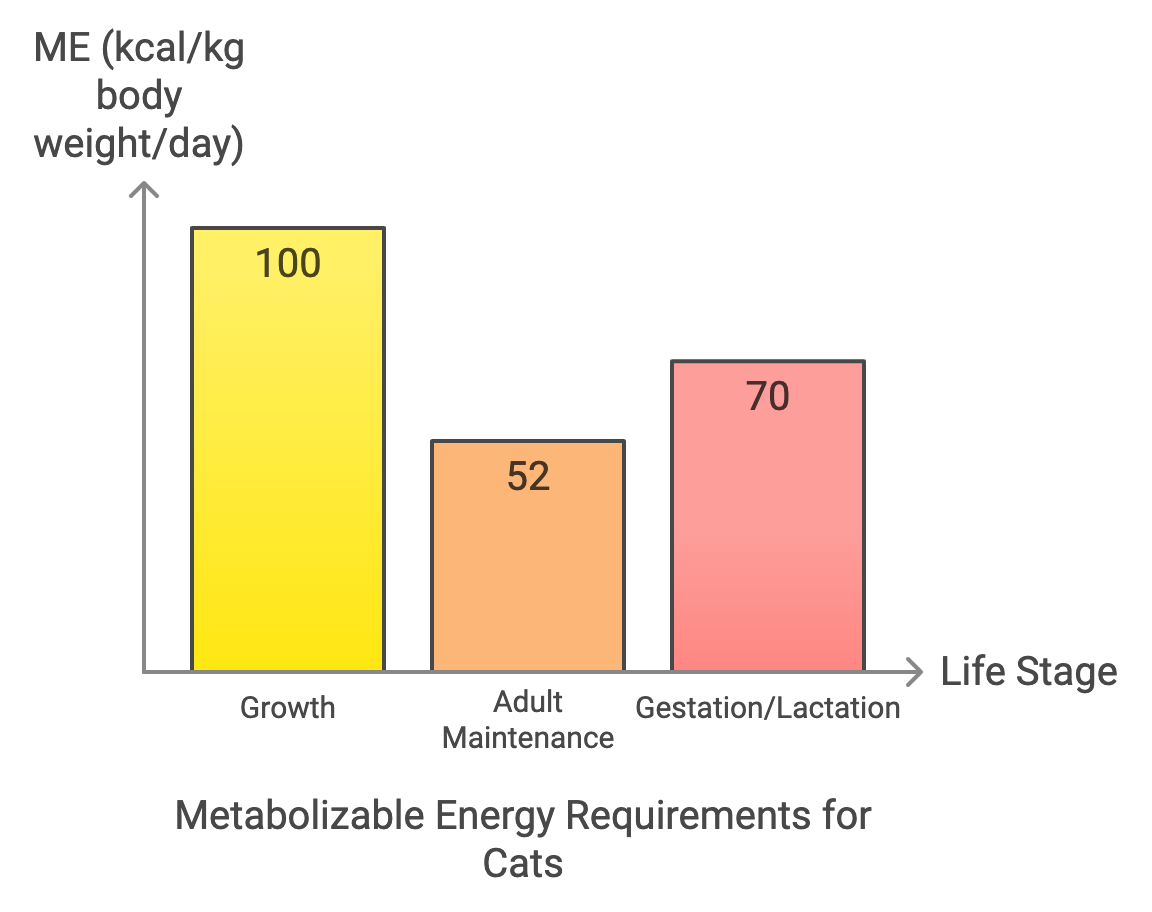
ME vs Calories: What’s the Difference?

While closely related, ME and calories are not identical. ME represents usable energy, while calories (or kilocalories) are a unit of measurement for energy. On dry cat food labels, calorie content typically refers to ME. A study of 82 dry cat foods found ME values ranging from 3,131 to 4,225 kcal/kg, with a mean value of 3,711 ± 244 kcal/kg.
Methods for Calculating Metabolizable Energy
The National Research Council (NRC) 2006 equation is considered the most accurate method for calculating ME in dry cat food:
ME (kcal/kg) = 4 × (10.0 × g protein + 8.5 × g fat + 3.5 × g nitrogen-free extract) – (0.73 × g protein + 0.77 × g fat + 0.72 × g nitrogen-free extract + 0.87 × g fiber)
This equation considers the energy contribution from protein, fat, and carbohydrates and energy losses. A study found that the NRC 2006 equation had the highest accuracy, with a correlation coefficient of 0.95 between predicted and measured ME values.
Using Food Labels to Estimate ME
The modified Atwater formula is a simplified method for estimating dry cat food’s metabolizable energy (ME) content. Here’s some additional information about it:
The modified Atwater formula calculates ME as follows:
ME (kcal/kg) = (3.5 × g protein) + (8.5 × g fat) + (3.5 × g carbohydrate)
This formula is widely used in the pet food industry due to its simplicity. However, it’s important to note that it has some limitations:
- Accuracy: A study on feline diets found that the modified Atwater equation underestimated measured metabolizable energy by approximately 12%. This suggests that it may not always provide accurate results for high-quality cat foods.
- Variability: The formula doesn’t account for differences in digestibility between ingredients. For example, a study on dog foods found that crude fiber (CF) measurements, which affect the calculation of carbohydrates, can be inaccurate and lead to variable ME values.
- Comparison with other methods: Compared to more complex calculation methods, such as those recommended by the National Research Council (NRC), the modified Atwater formula shows moderate correlation. A study found correlations of r = 0.86 and r = 0.91 between modified Atwater and NRC formulas for dog foods.
- Application in research: Despite its limitations, the modified Atwater formula is still used in research studies. For instance, it was used as a comparison point in a study investigating the digestibility of commercial cat diets with different perceived glycemic responses.
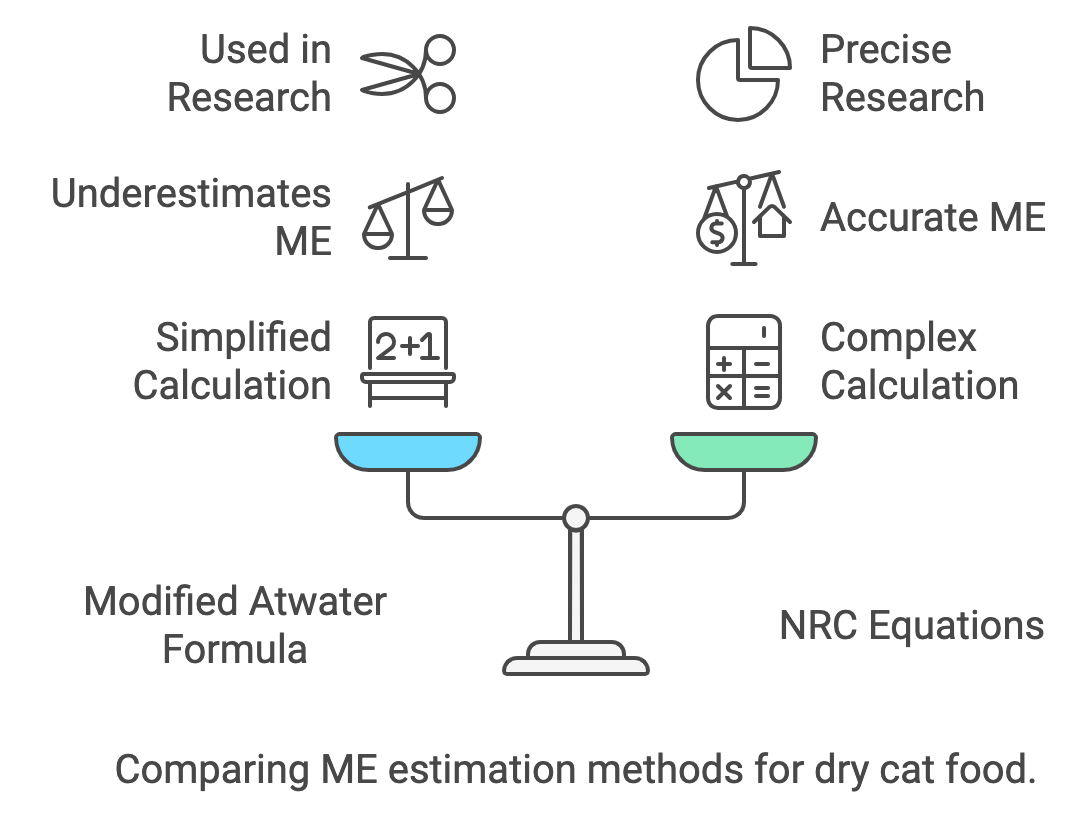
While the modified Atwater formula provides a quick and easy way to estimate ME in dry cat food, it’s important to recognize its potential inaccuracies. More complex methods like the NRC equations may be preferable for more precise calculations, especially in research or when formulating diets for cats with specific nutritional needs.
Digestible Energy vs. Metabolizable Energy in Cat Food #
Understanding Digestible Energy
Digestible energy (DE) in cat food refers to the total energy content of the food minus the energy lost in feces. It represents the amount of energy a cat can extract from the food through digestion. DE is typically measured in kilocalories (kcal) per kilogram of food.
The calculation of DE takes into account two main components:
Gross Energy (GE): This is the total energy content of the food, determined by completely burning the food in a bomb calorimeter.
Fecal Energy (FE): This is the energy content of the feces, which represents undigested food components.
The equation for calculating DE is:
DE = GE – FE
A study on energy evaluation in pet foods found that DE values for dry cat foods typically range from 3,800 to 4,500 kcal/kg. Cat foods’ energy digestibility can vary depending on factors such as ingredient quality and processing methods.
Difference Between Digestible and Metabolizable Energy
The main difference between digestible energy (DE) and metabolizable energy (ME) lies in the additional energy losses considered in ME calculations:
DE accounts only for fecal energy losses.
ME accounts for fecal, urinary, and gaseous energy losses.
The relationship between DE and ME can be expressed as:
ME = DE – (Urinary Energy + Gaseous Energy)
In practice, ME is typically about 8-10% lower than DE in cat foods. For example, if a dry cat food has a DE of 4,000 kcal/kg, its ME might be around 3,600-3,680 kcal/kg.
ME is considered a more accurate representation of the energy actually available for the cat’s metabolism. This is why most cat food labels and nutritional guidelines use ME rather than DE when reporting energy content.
A study comparing different energy estimation methods in pet foods found that the correlation between predicted and measured ME values was higher (r = 0.95) when using more complex equations that account for these additional energy losses, compared to more straightforward methods based solely on DE.
How Many Calories Does Your Cat Need? #
Daily Caloric Requirements for Cats
Cats’ caloric needs vary depending on factors such as age, weight, activity level, and health status. According to the National Research Council (NRC), adult cats’ average daily energy requirement is approximately 60-70 kcal per kilogram of body weight. However, this can range from 45-100 kcal/kg depending on individual factors.
Here’s a breakdown by life stage:
Kittens (0-6 months): 250-280 kcal/kg body weight/day
Junior cats (7 months-2 years): 100-120 kcal/kg body weight/day
Adult cats (3-7 years): 60-70 kcal/kg body weight/day
Mature cats (7-12 years): 55-65 kcal/kg body weight/day
Senior cats (12+ years): 50-60 kcal/kg body weight/day
Examples:
A 2-month-old kitten weighing 1 kg might need 250-280 kcal/day
A 1-year-old cat weighing 3 kg might need 300-360 kcal/day
A 5-year-old adult cat weighing 4 kg might need 240-280 kcal/day
A 10-year-old mature cat weighing 5 kg might need 275-325 kcal/day
Pregnant and lactating cats have higher energy requirements, often 2-3 times that of adult maintenance.

How to Adjust Caloric Intake Based on Activity and Weight
Adjusting caloric intake is important for cats to maintain a healthy weight. Here are some guidelines:
Sedentary or indoor cats: Reduce intake to about 80% of the average requirement.
Active or outdoor cats: Increase intake by 20-40% above the average requirement.
Weight loss: Reduce intake by 20-30% under veterinary supervision for overweight cats.
Weight gain: Increase intake by 10-20% for underweight cats and monitor progress closely.
Examples:
A sedentary 4 kg adult cat might need 192-224 kcal/day (80% of 240-280 kcal)
An active 4 kg adult cat might need 288-392 kcal/day (120-140% of 240-280 kcal)
For weight loss, a 6 kg overweight cat might be restricted to 252-294 kcal/day (70-80% of 360-420 kcal)
A study on feline obesity found that adjusting caloric intake based on body condition score and activity level led to successful weight management in 88% of cats over a 6-month period.
Kcal per Cup and Kilogram of Dry Cat Food
The caloric content of dry cat food can vary significantly between brands and formulations. On average:
Dry cat food contains about 3,000-4,000 kcal per kilogram.
A standard 8 oz cup of dry cat food typically contains 300-400 kcal.
However, these values can vary. A study analyzing 82 commercial dry cat foods found:
Energy density ranged from 3,131 to 4,225 kcal/kg.
The mean energy content was 3,711 ± 244 kcal/kg.
Examples of different formulations:
Kitten food: 3,800-4,200 kcal/kg
Adult maintenance: 3,500-3,800 kcal/kg
Weight management: 2,800-3,200 kcal/kg
Senior formula: 3,300-3,600 kcal/kg
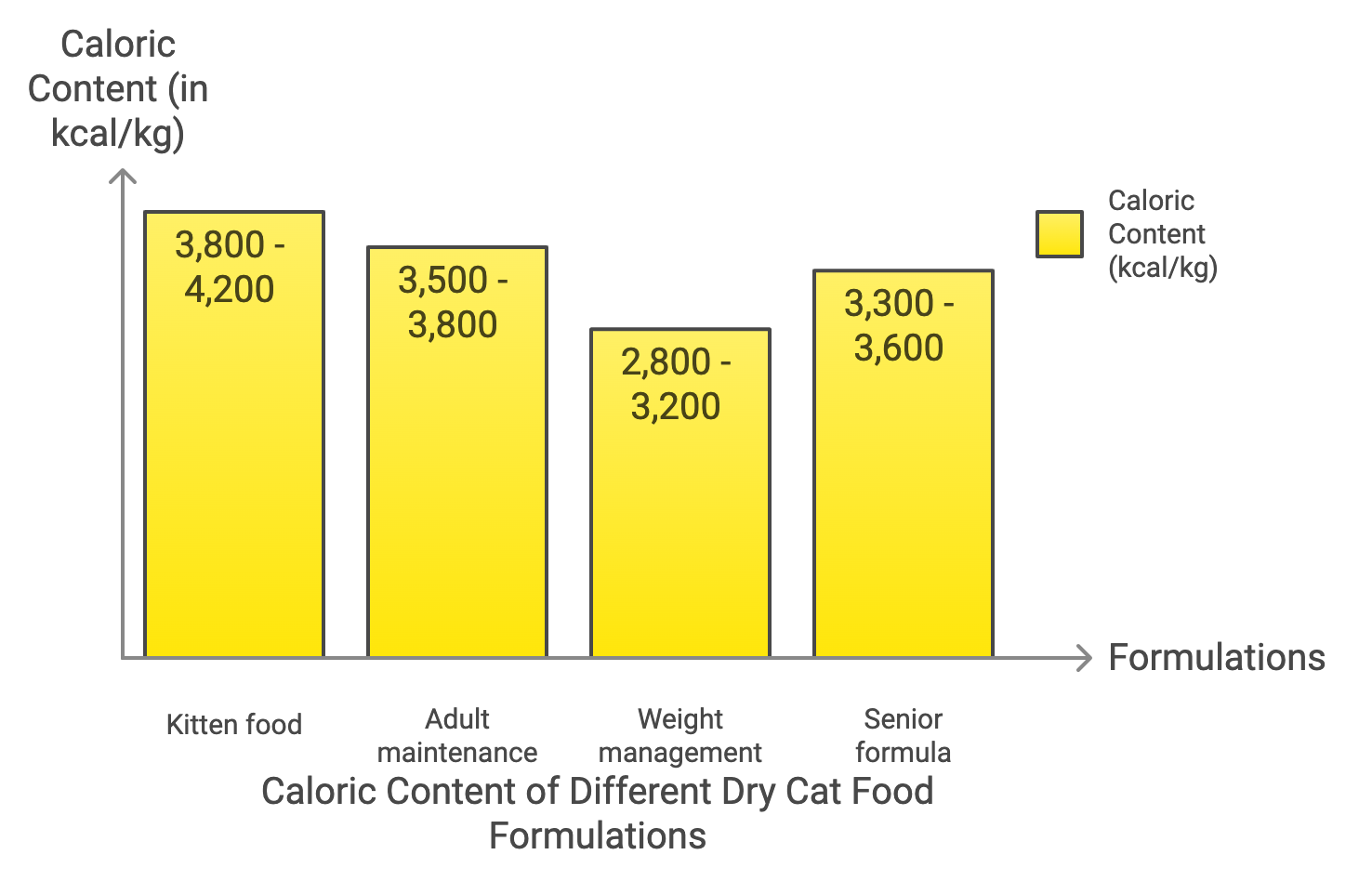
It’s important to check the specific calorie content on the food label, as it can differ significantly between products. Some weight management formulas may have as low as 2,500 kcal/kg, while high-energy formulas can exceed 4,500 kcal/kg.
Comparing Kcal and Metabolizable Energy Across Cat Food Brands #
Why Kcal and ME Vary Among Brands?
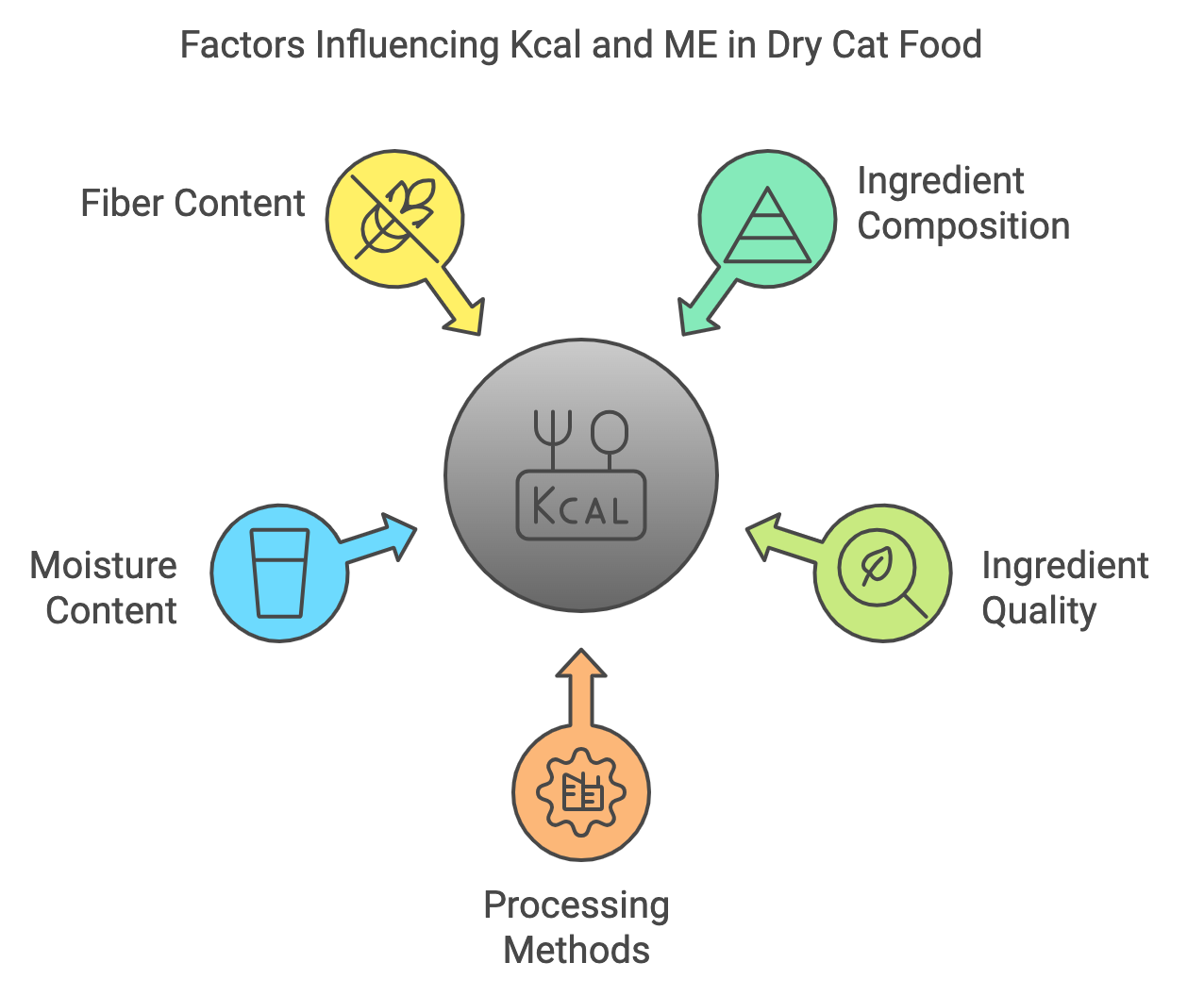
The kilocalorie (kcal) content and metabolizable energy (ME) of dry cat food can vary significantly between brands due to several factors:
Ingredient composition: Different brands use varying proportions of proteins, fats, and carbohydrates, directly affecting energy content. For example, high-fat formulas typically have higher kcal and ME values.
Ingredient quality: The digestibility of ingredients impacts the ME. Higher quality, more digestible ingredients result in greater ME.
Processing methods: Food processing can affect nutrient availability and digestibility, influencing the final ME.
Moisture content: Even among dry cat foods, slight variations in moisture can impact energy density.
Fiber content: Higher fiber content generally reduces the overall ME of the food.
A study analyzing 82 commercial dry cat foods found that energy density ranged from 3,131 to 4,225 kcal/kg, with a mean of 3,711 ± 244 kcal/kg. This wide range demonstrates the significant variation among brands.
How to Compare Kcal and ME Between Brands
To accurately compare kcal and ME between different cat food brands:
Standardize the unit of measurement: Ensure you’re comparing values in the same units (e.g., kcal/kg or kcal/cup).
Check the calculation method: Look for brands that use the NRC 2006 equation for ME calculation, as it’s considered the most accurate. The equation is:
ME = 4 × (10.0 × g protein + 8.5 × g fat + 3.5 × g nitrogen-free extract) – (0.73 × g protein + 0.77 × g fat + 0.72 × g nitrogen-free extract + 0.87 × g fiber)
Consider serving size: Compare the kcal per serving, as serving sizes vary between brands.
Evaluate nutrient density: A food with higher kcal/kg isn’t necessarily better; consider the nutrient profile alongside energy content.
Account for life stage formulations: Kitten foods typically have higher energy density than adult maintenance formulas.
Example comparison:
Brand A: 3,800 kcal/kg, 95 kcal/serving (1/4 cup)
Brand B: 3,600 kcal/kg, 100 kcal/serving (1/4 cup)
While Brand A has a higher energy density per kg, Brand B provides more calories per serving due to differences in food density or serving size definition.
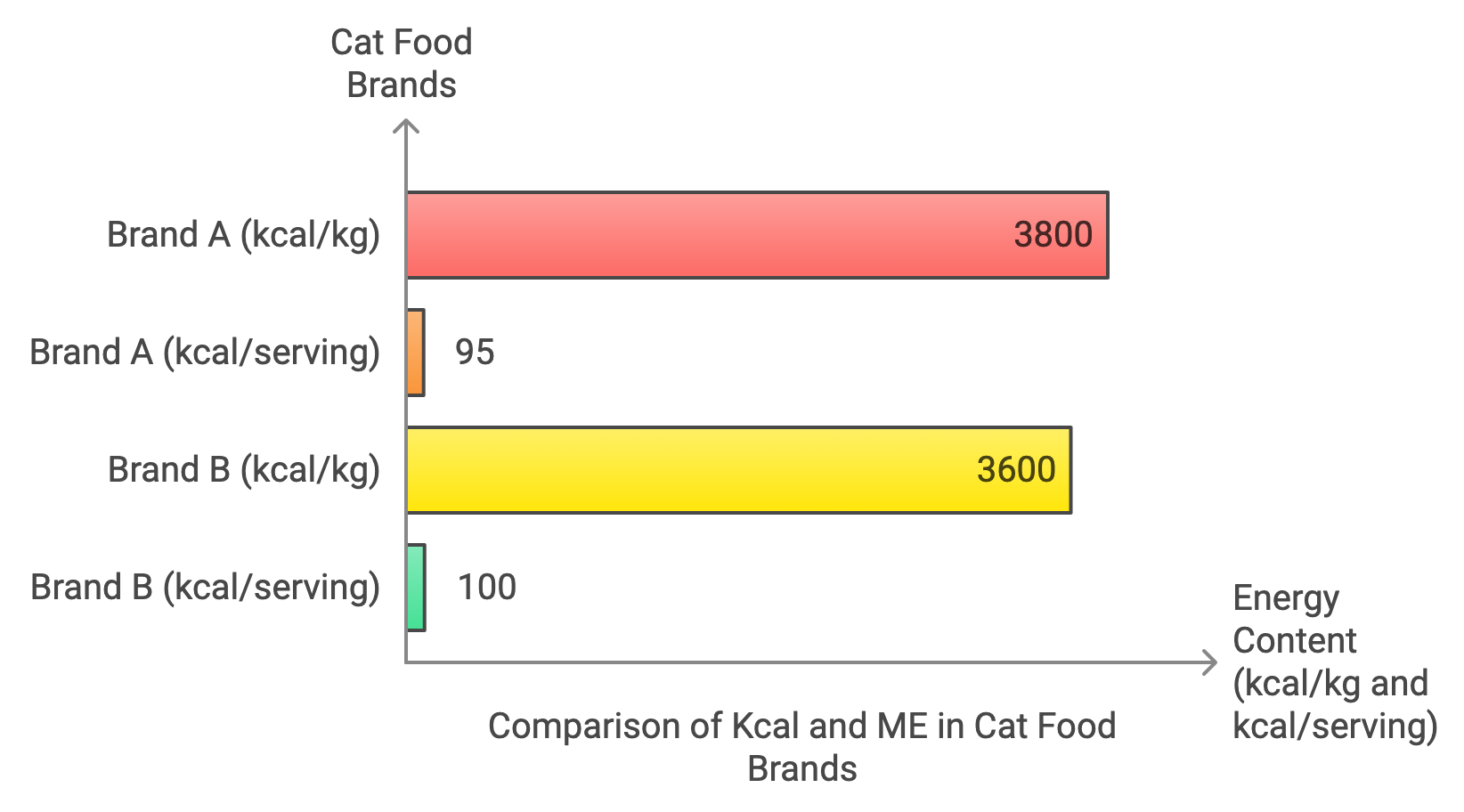
It’s important to note that the modified Atwater equation, which is still commonly used, tends to underestimate ME in high-quality cat foods. A study found that this equation underestimated measured ME by approximately 12%. Therefore, when possible, prefer brands that use the more accurate NRC 2006 equation for ME calculation.
When comparing brands, also consider the cat’s individual needs. For example, a highly active outdoor cat may benefit from a higher energy-density food. In contrast, a sedentary indoor cat might require a lower-calorie option to maintain a healthy weight.
Impact of Ingredients on Kcal and ME in Dry Cat Food #
How Ingredients Affect Caloric and Energy Values
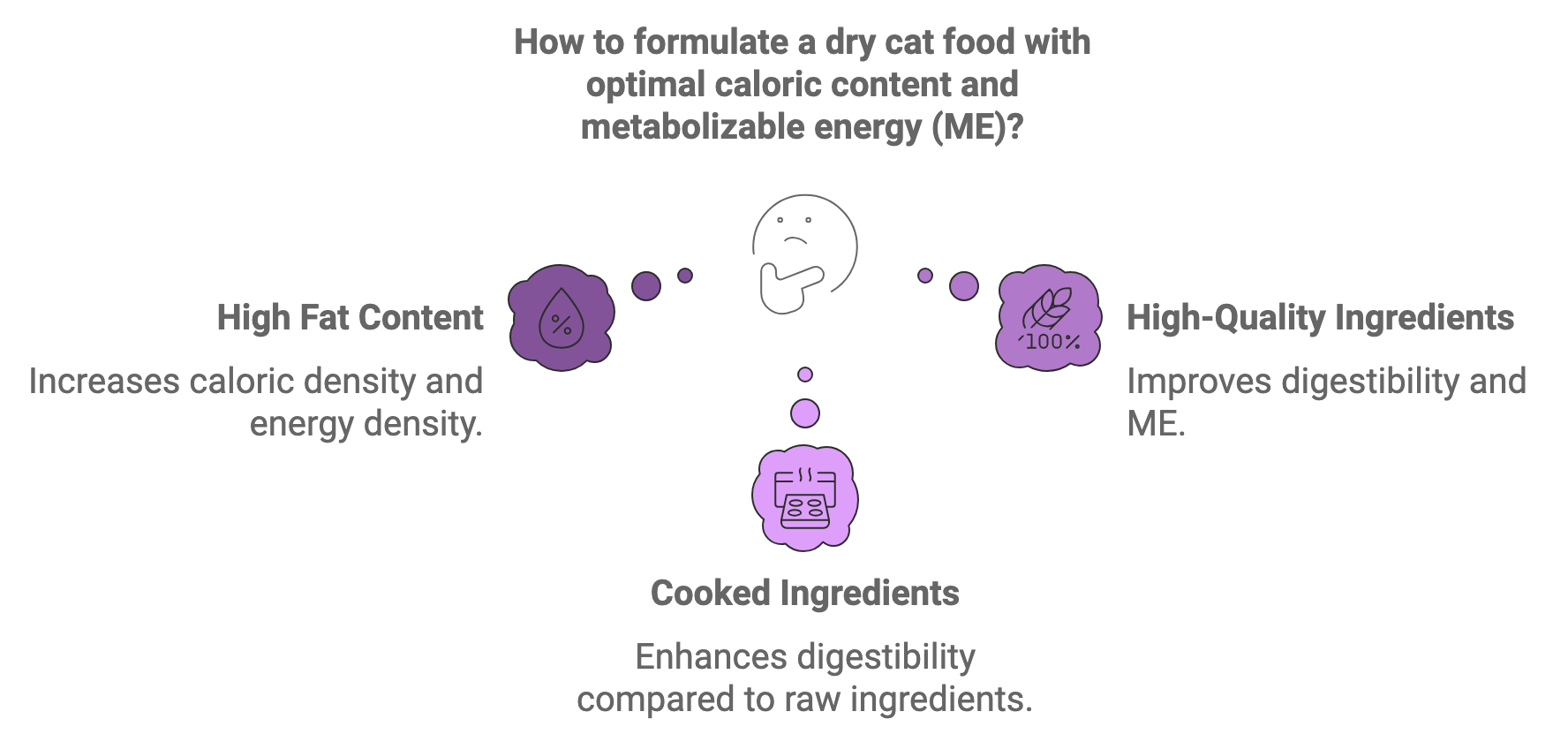
The choice of ingredients in dry cat food significantly influences its caloric content and metabolizable energy (ME). Different macronutrients contribute varying amounts of energy:
Proteins: 4 kcal/g
Carbohydrates: 4 kcal/g
Fats: 9 kcal/g
Foods with higher fat content tend to have higher caloric density. For example, a study analyzing 82 commercial cat foods found that energy density ranged from 3,131 to 4,225 kcal/kg, with variations largely attributed to differences in fat content.
Ingredient quality also affects ME. Higher quality, more digestible ingredients result in greater ME. For instance, animal-based proteins generally have higher digestibility than plant-based proteins, potentially leading to higher ME values.
The processing method of ingredients can also impact ME. Cooked ingredients often have higher digestibility than raw ones. A study on cooked navy bean powder in dog food showed it was highly digestible, with 78.22% crude protein digestibility.
Grain-Free vs Grain-Inclusive: Does it Affect ME?
The debate between grain-free and grain-inclusive cat foods has raised questions about their impact on ME. Current research suggests that the presence or absence of grains does not necessarily determine the ME of the food. Instead, the overall nutrient composition is more important.
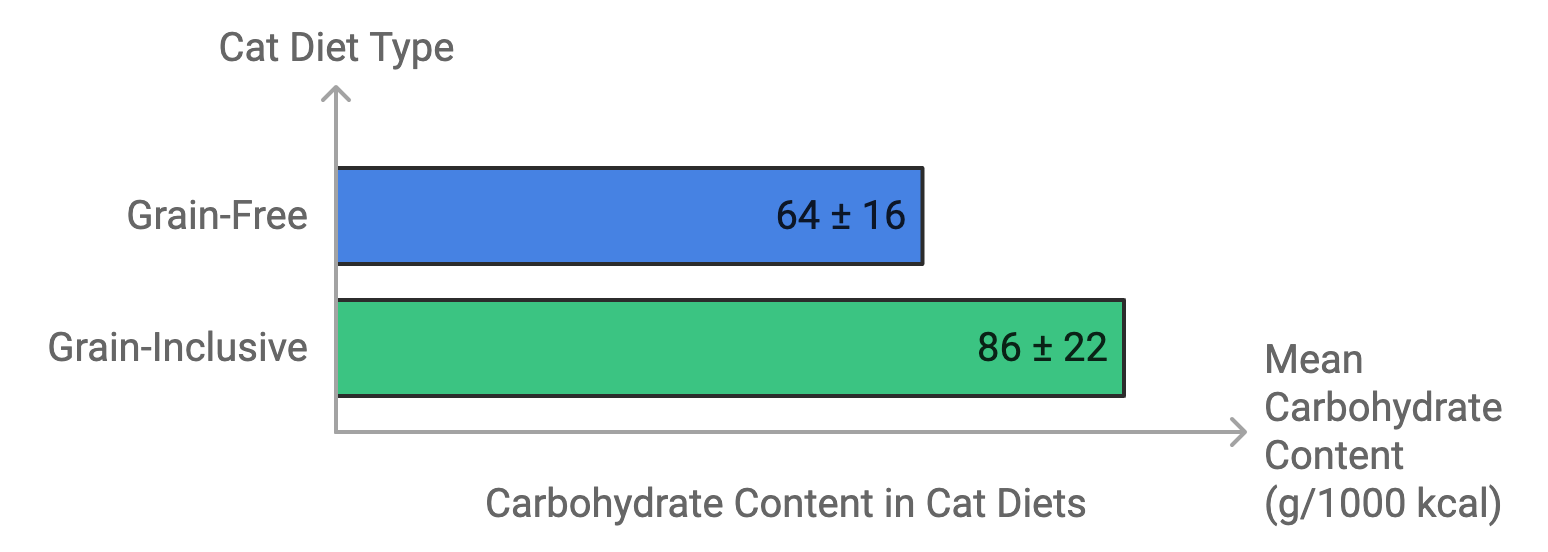
A study comparing grain-containing and grain-free dry cat diets found that:
Grain-free diets had a lower mean reported carbohydrate content (64 ± 16 g/1000 kcal) than grain-containing diets (86 ± 22 g/1000 kcal).
However, there was no significant difference in the overall energy density between grain-free and grain-containing foods.
It’s important to note that grain-free diets often replace grains with other carbohydrate sources like potatoes or legumes, which can have similar or even higher caloric content.
The impact on ME can vary depending on the specific ingredients used. For example:
A grain-free food using high amounts of animal fats might have higher ME than a grain-inclusive food with lower fat content.
A grain-inclusive food using highly digestible grains might have a similar ME to a grain-free food using less digestible alternative carbohydrates.
Misconceptions About Kcal and Metabolizable Energy in Cat Food #
Are Higher Kcal or ME Always Better?
A common misconception is that cat foods with higher kilocalorie (kcal) content or metabolizable energy (ME) are constantly superior. However, this is not necessarily true. The ideal energy content depends on various factors, including the cat’s age, weight, activity level, and health status.
Nutrient density: Higher kcal doesn’t always mean better nutrition. A study comparing 82 commercial dry cat foods found that while energy density varied from 3,131 to 4,225 kcal/kg, the nutrient profiles didn’t always correlate with energy content.
Overfeeding risk: High-energy foods can lead to overfeeding if portions aren’t adjusted accordingly. A long-term study on cats found that those fed ad libitum with high-energy diets were more likely to become overweight or obese.
Life stage appropriateness: While kittens and lactating queens benefit from high-energy diets, adult indoor cats often require lower energy density foods to maintain a healthy weight.
Example:
A 4 kg adult indoor cat requires approximately 240-280 kcal/day. Feeding a high-energy food (4,000 kcal/kg) would mean very small portions (60-70g/day), which might not satisfy the cat’s appetite or provide sufficient volume for digestive health.
Can Lower Kcal Foods Help with Weight Control?
Lower kcal foods can effectively control weight in cats, but it’s important to understand their proper use and limitations.
Effectiveness: A clinical study on overweight cats found that a low-calorie, high-fiber diet (3,100 kcal/kg) resulted in significant weight loss over eight (8) weeks when fed according to calculated energy requirements.
Satiety: Lower kcal foods often contain more fiber, which can help increase satiety. A study showed that cats fed a low-energy, high-fiber diet (3,190 kcal/kg) felt more satisfied and begged less than those on a standard diet (3,854 kcal/kg).
Nutrient balance: Lower-calorie foods must maintain proper nutrient balance. A review of commercial weight loss diets for cats found that while they effectively reduced calorie intake, some didn’t meet all nutrient requirements for adult cats.
Gradual transition: Sudden switches to low-calorie diets can lead to nutritional deficiencies if not properly managed. A study recommended a gradual transition over 7-10 days for digestive adaptation.
Example:
For a 6 kg overweight cat requiring weight loss, a diet of 3,200 kcal/kg might allow for 70-80g of food per day (224-256 kcal), providing more volume than a higher calorie option while still promoting weight loss.
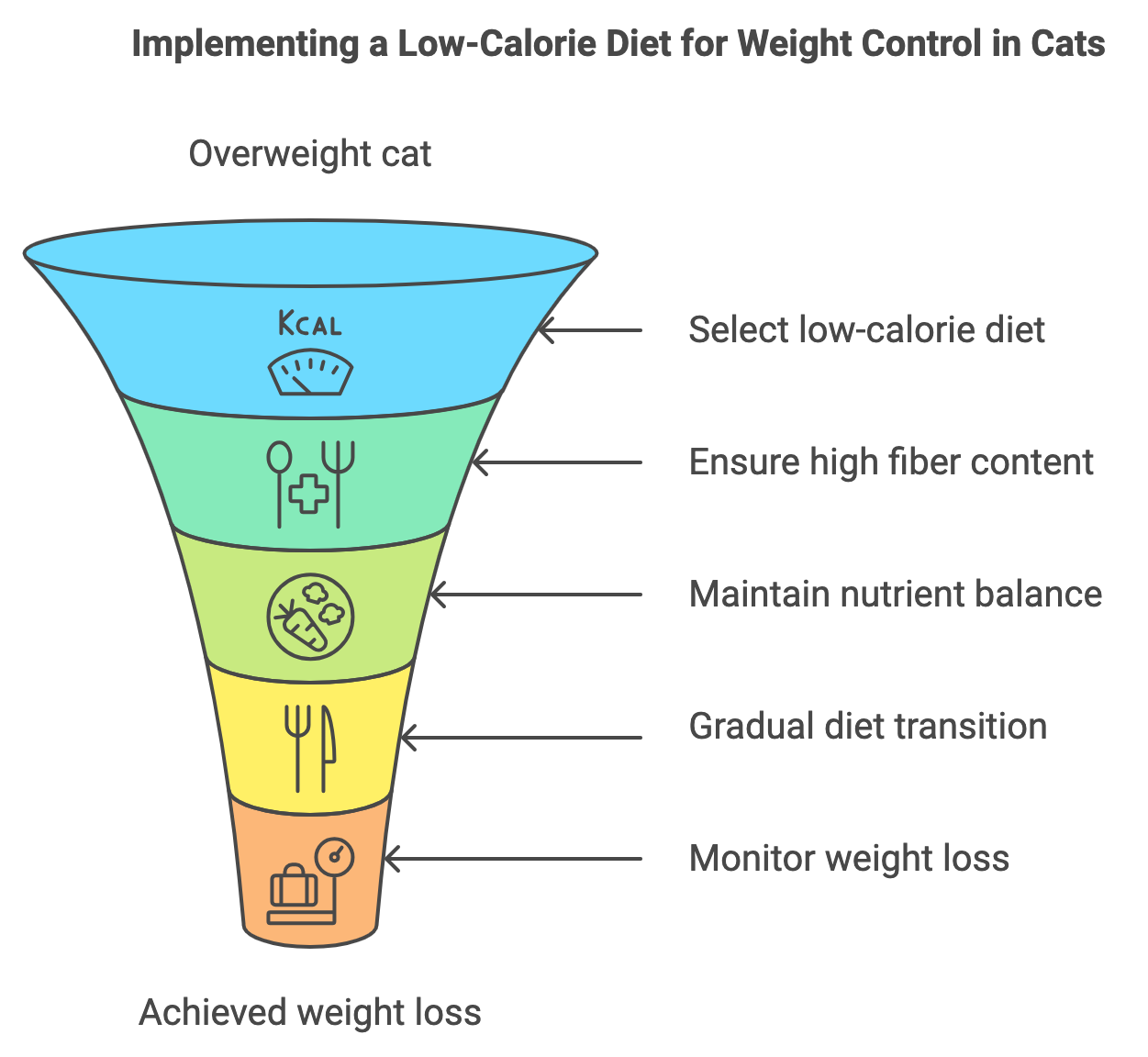
Choosing the Right Dry Cat Food Based on Kcal and ME #
How to Match Your Cat’s Needs to Kcal and ME
Selecting the appropriate dry cat food based on kilocalories (kcal) and metabolizable energy (ME) requires considering your cat’s individual needs:
Life stage: Kittens, adult cats, and senior cats have different energy requirements. For example, kittens need about 100 kcal ME/kg body weight, while adult cats typically require 52-70 kcal ME/kg body weight.
Activity level: More active cats require higher energy diets. Indoor cats often need fewer calories than outdoor cats.
Body condition: Overweight cats may benefit from lower calorie foods to aid weight loss, while underweight cats might need higher energy-density foods.
Health status: Cats with certain health conditions, such as diabetes, may require specific dietary considerations. For instance, diabetic cats often benefit from diets with ≤12-15% carbohydrate metabolizable energy.

When choosing a food, compare the kcal/kg or kcal/cup on the label to your cat’s calculated energy needs. Remember that higher kcal doesn’t always mean better nutrition – nutrient balance is crucial.
Tools to Calculate Your Cat’s Caloric and ME Requirements
Body Condition Scoring (BCS) Systems:
Nine-point BCS scale: This system has been validated for assessing body fat percentage in cats. A study found a strong correlation (r = 0.87) between BCS and body fat percentage measured by dual-energy x-ray absorptiometry (DEXA).
Five-point BCS system: Another study evaluated a five-point BCS system with half-point delineations, finding that percent body fat increased by approximately 7% within each step increase in BCS.
These scoring systems can help determine if a cat needs more or fewer calories based on their current body condition.
Online Calculators:
While not specifically mentioned in the search results, many veterinary websites and pet food companies offer online calorie calculators. These tools typically use factors such as weight, age, and activity level to estimate daily caloric needs.
Metabolic Equations:
Veterinarians often use equations to calculate a cat’s Resting Energy Requirement (RER) and then adjust for activity level. The most common equation is:
RER = 70 × (body weight in kg)^0.75
Veterinary Nutritional Status Score (VetNSS):A study mentioned using a VetNSS to monitor the nutritional status of hospitalized patients. This scoring system helped track changes in nutritional status over time.
DEXA Scans:While not practical for regular use, DEXA scans provide the most accurate body composition measurement, including fat and lean body mass. This can validate other scoring systems and calculate precise energy requirements.
Weight and Girth Measurements:
Although less accurate than BCS, weight and girth measurements can be used to estimate body fat percentage. A study found correlations between body fat percentage and weight (r = 0.74) and girth (r = 0.78).
Muscle Condition Score (MCS):
In addition to BCS, some veterinarians use MCS to assess lean body mass, which is crucial for determining energy requirements.
Food Manufacturer Guidelines:
Many cat food brands provide feeding guidelines based on weight and life stage. However, these should be used as a starting point and adjusted based on individual needs and regular BCS assessments.
It’s important to note that these tools provide estimates, and the actual energy requirements can vary based on factors such as health status, neutering status, and individual metabolism. Regular monitoring and adjustment are crucial for maintaining optimal body condition.
Resources #
Journal of Feline Medicine and Surgery
https://www.journals.elsevier.com/journal-of-feline-medicine-and-surgery
National Research Council’s Nutrient Requirements of Dogs and Cats
https://www.nap.edu/catalog/10668/nutrient-requirements-of-dogs-and-cats
Association of American Feed Control Officials (AAFCO) Guidelines
https://www.aafco.org/Consumers/What-is-in-Pet-Food
Cornell Feline Health Center
https://www.vet.cornell.edu/departments-centers-and-institutes/cornell-feline-health-center
Comparative Study Of Dry Cat Food Product Attributes – Science Diet vs Friskies
https://www.semanticscholar.org/paper/6a4c219d4850cda339d573b4682a2bd832fb3470
Energy Requirements and Food Intake in Cats
https://pubmed.ncbi.nlm.nih.gov/28569080
Evaluation of Phosphorus, Calcium, and Magnesium Content in Commercial Cat Foods
https://www.ncbi.nlm.nih.gov/pmc/articles/PMC6979088/
Energy Requirements for Cats: A Meta-Analysis
https://www.ncbi.nlm.nih.gov/pmc/articles/PMC34251295/
Frontiers in Veterinary Science: Evaluation of Calculated Energy Content of Commercial Cat Foods
https://www.frontiersin.org/articles/10.3389/fvets.2021.658395/full
A Review of Methods for the Calculation of Metabolizable Energy in Pet Foods
https://pubmed.ncbi.nlm.nih.gov/34251295/
Journal of Animal Science: Effects of Crude Fiber on Metabolizable Energy in Pet Foods
https://academic.oup.com/jas/article/77/5/1463/4631654
National Research Council (NRC) 2006: Energy Equations for Pet Foods
https://www.nap.edu/catalog/10668/nutrient-requirements-of-dogs-and-cats
Comparative Study: Grain-Free vs Grain-Containing Diets in Cats
https://pubmed.ncbi.nlm.nih.gov/34167340/
Journal of Nutrition: A Review of the Digestibility of Different Pet Food Ingredients
https://pubmed.ncbi.nlm.nih.gov/22367072/
Journal of Animal Science: Evaluation of Dry Cat Foods Across Brands
https://www.ncbi.nlm.nih.gov/pmc/articles/PMC5753634/
Journal of Animal Physiology and Animal Nutrition: Energy Content of Diets for Cats
https://onlinelibrary.wiley.com/doi/abs/10.1111/jpn.12900
Evaluation of Calculated Energy Content in Pet Foods
https://pubmed.ncbi.nlm.nih.gov/36941733/
Journal of Animal Physiology and Animal Nutrition: Effects of Cooked Navy Bean Powder in Dog Food
https://pubmed.ncbi.nlm.nih.gov/22367072/
Journal of the American Veterinary Medical Association
https://avmajournals.avma.org/journal/javma
Energy Evaluation of Commercial Cat Foods
https://pubmed.ncbi.nlm.nih.gov/25646332/
Journal of Feline Medicine and Surgery: Nutritional Needs of Cats Across Life Stages
https://pubmed.ncbi.nlm.nih.gov/34167337/
Journal of Nutritional Science: Comparison of Predictive Equations for Energy Content
https://www.cambridge.org/core/journals/journal-of-nutritional-science/article/comparison-of-predictive-equations-for-energy-content-of-commercial-pet-foods/B9659F7D0C11D75F14F0FD950D2F0D10
Journal of Feline Medicine and Surgery: Dietary Management of Obesity in Cats
https://pubmed.ncbi.nlm.nih.gov/32326864/
PubMed: Resting Energy Requirements in Cats
https://pubmed.ncbi.nlm.nih.gov/10407486/
Journal of Animal Physiology and Animal Nutrition: Effects of Different Nutrient Densities in Cats
https://pubmed.ncbi.nlm.nih.gov/35641141/
Journal of Nutrition: Effects of Dietary Fiber on Satiety in Cats
https://pubmed.ncbi.nlm.nih.gov/35209767/
Journal of Animal Science: Metabolizable Energy in Cats
https://pubmed.ncbi.nlm.nih.gov/34167340/
Journal of Animal Physiology and Animal Nutrition: Digestibility of Commercial Diets
https://pubmed.ncbi.nlm.nih.gov/21453142/
Journal of Nutrition: Effects of Macronutrient Composition on Feline Energy Intake
https://pubmed.ncbi.nlm.nih.gov/29393723/
Journal of Animal Science: A Comparison of Predictive Equations for Energy Content in Pet Foods
https://pubmed.ncbi.nlm.nih.gov/31302037/
Journal of Animal Science: Dietary Fiber’s Impact on Energy Content in Pet Foods
https://pubmed.ncbi.nlm.nih.gov/26456847/
Journal of Veterinary Medicine: Nutritional Needs for Senior Cats
https://pubmed.ncbi.nlm.nih.gov/11789619/
PubMed: Resting Energy Requirement in Cats
https://pubmed.ncbi.nlm.nih.gov/10407486/

